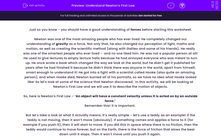Just so you know - you should have a good understanding of forces before starting this worksheet.
Newton was one of the most amazing people who has ever lived. He completely changed our understanding of gravity as a force. Not only that, he also changed our perception of light, maths and motion, as well as creating the scientific method (along with Galileo and some of his friends). He really was one of the smartest people who ever lived - and no one liked him. He was not a popular person at all! He used to give lectures to empty lecture halls because he had annoyed everyone who was meant to turn up. He once wrote a book which changed the way we look at the world, but he didn’t get it published for years after he had finished it because he didn’t think there was anyone in the world, apart from himself, smart enough to understand it! He got into a fight with a scientist called Hooke (also quite an amazing person), and when Hooke died, Newton burned all of his portraits, so we have no idea what Hooke looked like! So let's look at some of the science that Newton discovered. In this activity, we will be looking at Newton's First Law and we will use it to describe the motion of objects.
So, here is Newton's First Law – ‘An object will have a constant velocity unless it is acted on by an outside force.’
Remember this! It is important.
But let’s take a look at what it actually means. It’s really simple - let’s use a teddy as an example! If the teddy is not moving, then it won’t move (obviously). If something comes and applies a force to it (for example if you push it), then it will start to move. If you did this in space where there is no friction, then the teddy would continue to move forever, but on the Earth, there is the force of friction that slows the bear down until it stops. Then it won’t move until you push it again.
There has to be a force applied for an object to accelerate or decelerate – otherwise, it won’t move or it will keep on moving at the same speed.
Let’s look at someone in a drag race going at top speed. The lights turn green and you floor the accelerator. The car lurches forward really fast - there is an acceleration. This means that there must be a force provided by the car pushing it forward. As the car gets faster and faster, it starts to pick up more and more resistance from the air and the road. This begins to slow down the acceleration of the car as the forces become more and more balanced. When they are balanced again, the car has reached its maximum speed and there is no more force to accelerate it anymore – this is called its terminal velocity.
That's it! Let's have a go at some questions on this now.








